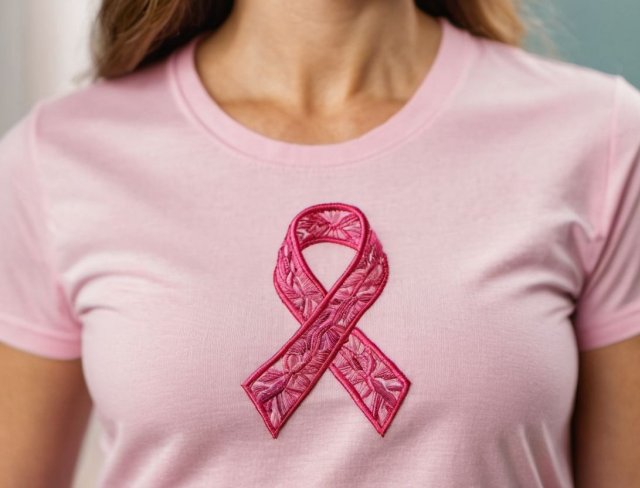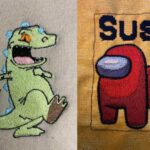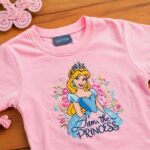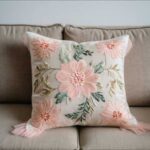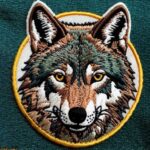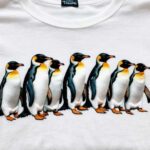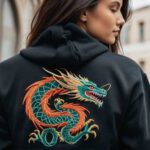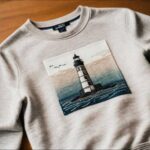Dressed Down
A Guide To Embroidered Shirts
Introduction
Embroidered shirts represent a fusion of art and fashion, offering a unique way to elevate your style with intricate designs and exquisite craftsmanship. In this detailed guide, we explore everything you need to know about embroidered shirts, from the types of fabrics used to the various styles and placement options for embroidery. Whether you’re a fashion enthusiast looking to expand your wardrobe or simply curious about the world of embroidered apparel, this article is your ultimate resource for mastering the art of embroidered shirts.
Embroidery has a rich history spanning cultures and centuries, with each stitch telling a story and carrying deep cultural significance. From traditional motifs passed down through generations to modern interpretations of classic designs, embroidered shirts encapsulate the essence of craftsmanship and creativity. By delving into the world of embroidered shirts, you embark on a journey of exploration and self expression, where every stitch becomes a canvas for personal style and artistic expression. Join us as we unravel the intricate threads of embroidered shirts and discover the beauty and meaning woven into each masterpiece.
Understanding Shirt Materials
The foundation of any embroidered shirt lies in its fabric, which not only serves as the canvas for intricate designs but also influences its overall look, feel, and durability. Let’s explore the characteristics of some common shirt materials:
Cotton: Known for its breathability, softness, and durability, cotton is a popular choice for everyday wear. It absorbs moisture well, making it comfortable to wear in various climates, and its versatility allows for a wide range of embroidery styles. Whether you prefer crisp cotton poplin for a tailored look or soft jersey knit for a more relaxed vibe, cotton shirts provide an excellent base for embroidered designs.
Silk: Renowned for its luxurious feel and lustrous appearance, silk adds an element of elegance to embroidered shirts. Its smooth surface allows for intricate detailing and vibrant colors, making it ideal for formal or special occasion wear. However, silk can be delicate and requires gentle care to maintain its beauty over time. Embroidered silk shirts exude sophistication and refinement, making them a timeless addition to any wardrobe.
Linen: Lightweight and breathable, linen offers a relaxed yet refined aesthetic that is perfect for casual embroidered shirts. Its natural texture adds visual interest to embroidered designs, giving them a rustic charm. While linen has a tendency to wrinkle, it softens with each wash, enhancing its comfort and appeal over time. Embroidered linen shirts are ideal for warm weather wear, providing a laid back elegance that is both stylish and comfortable.
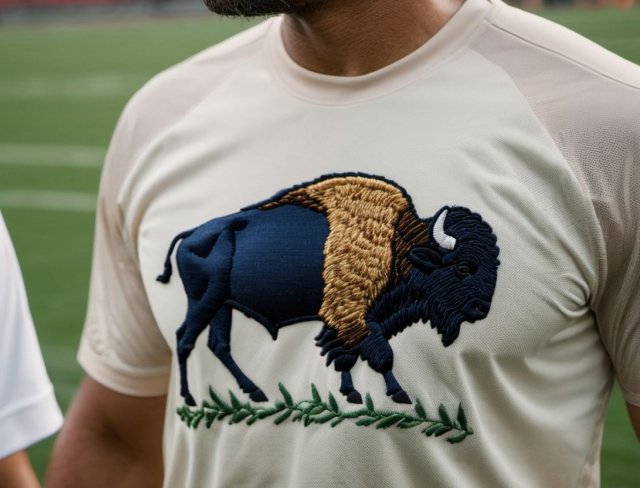
Polyester: Synthetic fabrics like polyester offer durability and color retention, making them a practical choice for embroidered shirts that require frequent washing or exposure to harsh conditions. Polyester blends combine the best qualities of natural and synthetic fibers, offering the comfort of cotton with the durability of polyester. Embroidered polyester shirts are easy to care for and maintain, making them a convenient option for everyday wear.
Blends: Fabric blends, such as cotton/polyester or silk/cotton blends, offer the benefits of multiple fibers, combining the softness of natural fibers with the durability of synthetics. These versatile fabrics provide the best of both worlds, offering comfort, durability, and ease of care. Embroidered shirts made from fabric blends are suitable for a wide range of occasions, from casual outings to formal events.
Understanding the characteristics of different shirt materials allows you to select the perfect canvas for your embroidered masterpiece. Whether you prefer the timeless elegance of silk, the casual comfort of cotton, or the rustic charm of linen, there’s a shirt material to suit every style and occasion. Experiment with different fabrics to discover the perfect combination of comfort, durability, and aesthetic appeal for your embroidered shirts.
Exploring Shirt Styles
Embroidered shirts come in a diverse array of styles, each offering its own unique aesthetic and functionality. Let’s delve into the characteristics of some common shirt styles:
Polo Shirts: With their sporty yet sophisticated appeal, polo shirts are a timeless wardrobe staple. Characterized by their collared neckline, buttoned placket, and short sleeves, polo shirts offer a versatile canvas for embroidered designs. Traditionally made from cotton pique fabric, polo shirts are known for their durability and comfort, making them ideal for casual wear. Embroidered polo shirts add a touch of sophistication to any ensemble, whether paired with chinos for a polished daytime look or jeans for a relaxed weekend vibe.
Button Down Shirts: Button down shirts exude classic elegance with their structured silhouette and buttoned front closure. Available in a variety of fabrics, including cotton, linen, and silk, button down shirts offer endless possibilities for embroidery placement and design. From subtle chest embroidery for a refined look to bold back panel designs for a statement making ensemble, button down shirts provide ample space for creativity and customization. Whether worn tucked into tailored trousers for a formal occasion or left untucked with jeans for a more relaxed vibe, embroidered button down shirts elevate any outfit with sophistication and style.
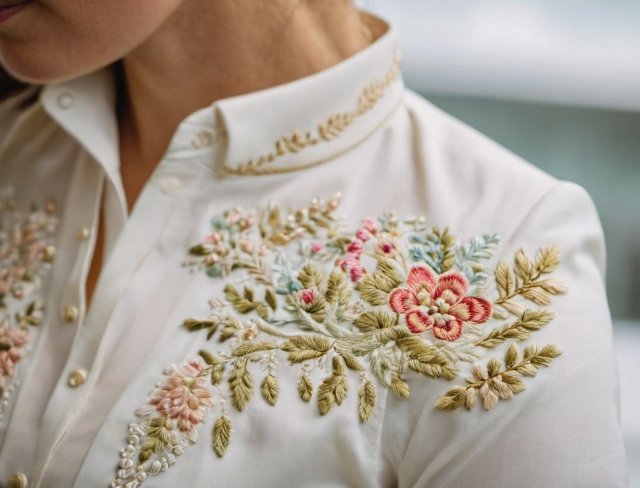
T-shirts: T-shirts offer a laid back canvas for embroidered designs, with their relaxed fit and casual aesthetic. Made from soft, breathable fabrics such as cotton jersey or blends, T-shirts are comfortable to wear and easy to style. Embroidered T-shirts allow for bold and expressive designs, ranging from graphic logos to intricate patterns. Whether adorned with a small chest emblem for subtle sophistication or a large, eye catching motif for maximum impact, embroidered T-shirts add a touch of personality to any ensemble. Pair them with denim shorts for a casual daytime look or layer them under a blazer for a more polished appearance.
Sweatshirts: Sweatshirts offer a cozy yet stylish option for embroidered designs, with their relaxed fit and soft, fleece lined interior. Made from cotton or cotton/polyester blends, sweatshirts provide warmth and comfort during cooler months. Embroidered sweatshirts allow for creative expression, with designs ranging from subtle chest emblems to bold graphic motifs. Whether worn with joggers for a laid back athleisure look or paired with tailored trousers for a high/low style mix, embroidered sweatshirts add a touch of personality and flair to any outfit.
Understanding the characteristics of different shirt styles allows you to select the perfect canvas for your embroidered designs. Whether you prefer the sporty sophistication of polo shirts, the classic elegance of button downs, or the casual comfort of T-shirts and sweatshirts, there’s a shirt style to suit every taste and occasion. Experiment with different fabrics, styles, and embroidery placements to create custom designs that reflect your individuality and personal style.
Embracing Pattern Placement Options
One of the most exciting aspects of embroidered shirts is the endless array of placement options for embellishments. From traditional chest embroidery to unconventional placements on sleeves, collars, and pockets, the possibilities are limited only by your imagination.
Chest Embroidery: The chest area is a classic and popular placement option for embroidered designs on shirts. Positioned front and center, chest embroidery serves as a focal point that draws the eye and adds a touch of sophistication to any ensemble. Whether it’s a small emblem or a larger motif, chest embroidery allows for subtle yet impactful customization. Designs can range from simple logos or monograms to intricate patterns and motifs, making chest embroidery a versatile choice for expressing personal style.
Sleeve Embroidery: Sleeves offer a dynamic canvas for embroidered designs, adding visual interest and movement to shirts. Whether positioned along the upper arm or wrapping around the cuff, sleeve embroidery allows for creative expression and customization. From bold stripes and geometric patterns to delicate floral motifs and intricate detailing, sleeve embroidery can complement or contrast with chest designs, adding depth and dimension to the overall look.
Collar and Cuff Embroidery: Collars and cuffs provide unique opportunities for embroidered embellishments, adding a touch of flair to traditional shirt styles. Embroidered collars can feature intricate patterns or motifs that frame the neckline and draw attention to the face, while cuff embroidery adds a subtle yet stylish accent to shirt sleeves. Whether it’s a delicate lace inspired design or a bold geometric pattern, collar and cuff embroidery allows for customization that reflects personal taste and style.
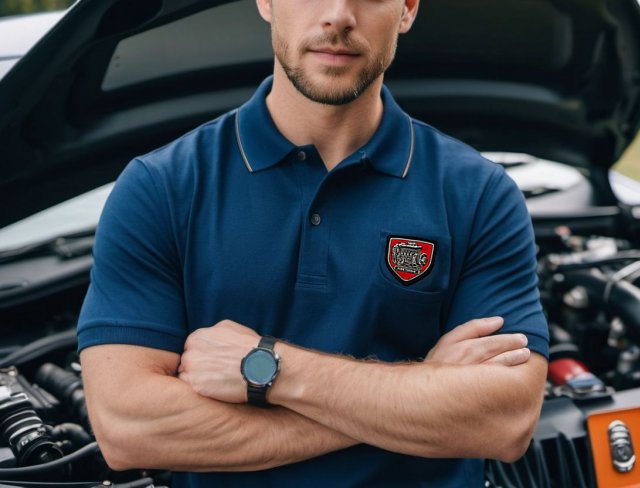
Pocket and Back Panel Embroidery: For a more unconventional approach to shirt embellishments, consider embroidering designs on pockets or back panels. Pocket embroidery adds a playful twist to classic shirt styles, serving as a subtle yet eye catching detail. Back panel embroidery, on the other hand, offers a bold statement piece that commands attention. Whether it’s a whimsical motif on the pocket or a large scale design spanning the back panel, these placement options allow for creative experimentation and customization.
Across the Hem or Side Seam: For a subtle yet unexpected touch, consider embroidering designs across the hem or along the side seam of shirts. This placement option adds a discreet yet stylish detail that catches the eye without overpowering the overall look. Whether it’s a small logo or a repeating pattern, hem and side seam embroidery offer a unique way to personalize shirts and make them truly one of a kind.
Embracing different placement options allows you to create custom designs that reflect your personality and style preferences. Whether you prefer traditional chest embroidery, bold sleeve designs, or unconventional placements like collar and cuff embellishments, the possibilities are endless. Experiment with different placements, sizes, and designs to create embroidered shirts that stand out and make a statement.
Embroidered Shirt Techniques
Embroidery can be executed using either traditional handcrafted techniques or modern machine stitching methods, each offering its own unique advantages and aesthetic qualities. Whether you choose hand embroidery or machine embroidery for your shirt projects, mastering the following techniques is essential for achieving professional quality results:
• Thread Selection: Choosing the right thread is crucial for achieving vibrant, long lasting embroidery on shirts. Opt for high quality embroidery thread that is colorfast, durable, and has a smooth texture to ensure optimal stitch quality. Consider the color, sheen, and weight of the thread to complement your design and fabric choice.
• Needle Choice: Selecting the appropriate needle is essential for smooth and precise stitching in shirt embroidery. Use sharp embroidery needles with a size suitable for your fabric type and design complexity. For delicate fabrics, choose finer needles to minimize damage, while heavier fabrics may require larger needles for proper penetration.
• Stabilizing Techniques: Stabilizing the fabric during embroidery is essential for preventing distortion and ensuring clean, professional results. Explore various stabilizing techniques such as using tear-away or cut-away stabilizers, adhesive backing, or hoopless embroidery methods, depending on the fabric and design requirements.
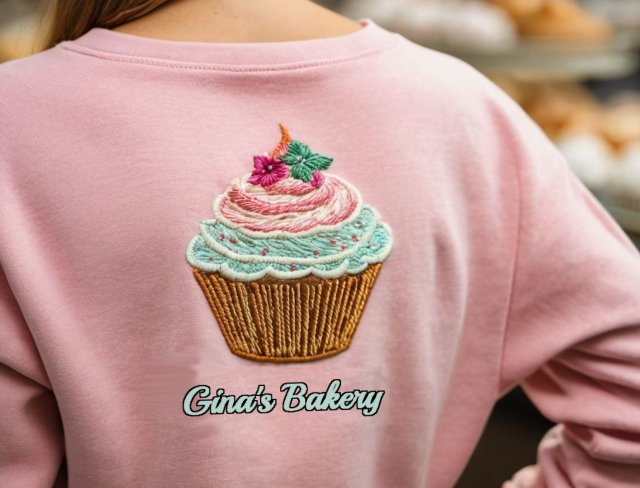
• Tension Adjustment: Proper tension adjustment is critical for achieving even and consistent stitches in shirt embroidery. Experiment with tension settings on both hand and machine embroidery setups to accommodate different fabrics and achieve optimal stitch quality. Ensure the tension is balanced to prevent puckering or thread breakage.
• Special Considerations for Stretch Fabrics: Embroidering on stretchy fabrics commonly used in shirt construction, such as jersey or spandex blends, requires special considerations to avoid distortion and puckering. Use stabilizers specifically designed for stretch fabrics and adjust tension settings accordingly to accommodate the fabric’s elasticity. Consider using a ballpoint needle to prevent snagging or tearing.
• Finishing Techniques: Post embroidery finishing techniques are essential for giving embroidered shirts a polished and professional appearance. Trim excess stabilizer carefully, remove basting stitches, and press the embroidered area gently with a pressing cloth to flatten any puckering and set the stitches. Pay attention to detail to ensure a flawless finish that enhances the overall look of the shirt.
• Hooping Difficult Fabrics: Embroidering on difficult fabrics, such as stretchy materials or delicate weaves, requires special care and attention to ensure optimal results. When hooping a shirt with a difficult fabric, consider using a stabilizer or backing to provide support and prevent puckering. Additionally, adjusting the tension of the hoop can help accommodate the fabric’s unique properties without distorting the design.
• Adjusting Stitch Spacing: Spacing between stitches plays a crucial role in achieving optimal embroidery results, especially on difficult fabrics. Too much tension between stitches can cause the fabric to pucker or distort, while too little tension can result in gaps or uneven stitches. Experiment with different stitch lengths and densities to find the perfect balance that ensures smooth, even coverage without compromising the fabric’s integrity.
• The Role of Fill Underlay: Fill underlay is a preparatory stitch that provides stability and coverage for subsequent embroidery layers, particularly on difficult fabrics. By laying down a foundation of fill stitches before adding decorative top stitches, fill underlay helps prevent fabric distortion and ensures crisp, clean embroidery results. Experiment with different fill stitch patterns and densities to find the optimal underlay for your specific fabric and design.
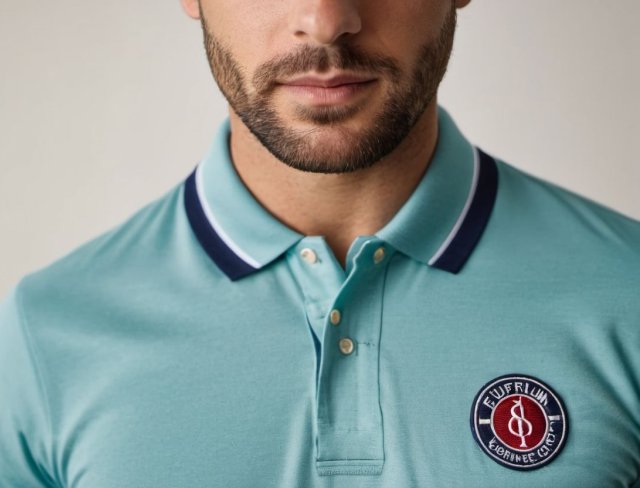
• Additional Tips and Tricks: Embroidering on difficult fabrics may present unique challenges, but with the right techniques and strategies, you can achieve professional quality results with confidence. Consider using a sharp embroidery needle and high quality thread suited to your fabric type for optimal performance. Take your time to carefully plan and test your embroidery design before stitching to avoid costly mistakes or rework. And most importantly, don’t be afraid to seek guidance from experienced embroiderers or online resources for troubleshooting tips and advice.
By mastering these embroidery techniques, both handcrafted and machine stitching, you can achieve stunning embroidered shirts that showcase your creativity and attention to detail. Experiment with different materials, designs, and techniques to create custom pieces that elevate your wardrobe with style and sophistication.
Conclusion
Mastering the art of embroidered shirts requires a combination of skill, creativity, and attention to detail. By understanding the nuances of shirt materials, styles, placement options, and embroidery techniques, you can create custom designs that reflect your individuality and style preferences. Whether you’re embroidering on cotton, silk, or challenging fabrics, embracing the right techniques and strategies ensures professional quality results that elevate your wardrobe with sophistication and flair.
Embroidered shirts not only serve as a canvas for artistic expression but also carry cultural significance and personal meaning. Each stitch tells a story, whether it’s a traditional motif passed down through generations or a modern interpretation of classic designs. By delving into the world of embroidered shirts, you not only elevate your style but also connect with a rich heritage of craftsmanship and creativity that spans cultures and centuries.
As you embark on your journey of exploration and self expression with embroidered shirts, remember to embrace the process with patience and passion. Experiment with different materials, styles, and techniques, and don’t be afraid to push the boundaries of creativity. Whether you’re adding a subtle touch of embroidery to your everyday wardrobe or making a bold statement with a bespoke design, embroidered shirts allow you to showcase your unique personality and style with every stitch. So, immerse yourself in the world of embroidered shirts, and let your creativity shine through with every thread.
Now that you have read through this article, feel free to SHOP for products we have created. If you are looking for something special which isn’t in our store, feel free to contact us.

